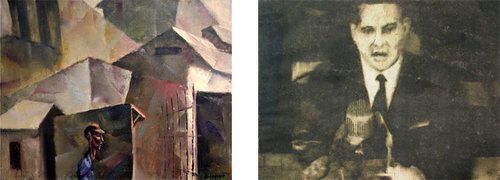David P. Levine
dal 24/2/2006 al 21/4/2006
Segnalato da
24/2/2006
David P. Levine
Tobey C. Moss Gallery, Los Angeles
In Memorium. Levine was recognized early for his paintings, watercolors and drawings of both California and Mexico capturing the flavor of the cities and villages, landscapes and people during the Depression of the 1930s and early 40s.

(1910 - 2005): In Memorium
The Artist as Social Critic: Paintings, Drawings, Prints
Born in South Pasadena, David P. Levine graduated from Los Angeles High School in 1929. He attended University of Southern California, and continued his studies in fine art at the Art Center School of Design and in New York. In about 1938, he married and he and his wife moved to Mexico until 1941, when World War II began.
Levine was recognized early for his paintings, watercolors and drawings of both California and Mexico capturing the flavor of the cities and villages, landscapes and people during the Depression of the 1930s and early 40s. His subjects and media evolved over the years and he continued painting until a day before his death.
The early paintings of David P. Levine expose the bewildering poverty and desperation felt during the Depression years of the 1930s in the United States: The Factory Gates - closed, The Stranger - homeless, Home on Wheels - abandoned railway cabooses invaded by homeless, Skylights and Rooftops - a birds eye view of an empty industrial site.
His later work - acrylic paintings and assemblages - reveal the signs and symbols that dominate the contemporary landscape.
Since 1934 David P. Levines work has been exhibited at Los Angeles County Museum; Riverside Museum, NY; the Portland Art Museum; the Carnegie Institute, PA; the Denver Art Museum; San Diego Museum of Art; Seattle Art Museum; San Francisco Museum of Fine Art; the Santa Barbara Museum of Art; Yale University Art Gallery, CT; Museo de Monterey, Mexico; Phoenix Art Museum, AZ; Davis Art Galleries of Wellesley College, MA; the Magnes Museum, Berkeley, CA and in professional art galleries in Los Angeles, San Francisco, Newport Beach, CA. His work is in many private and museum collections. In 2005 he received a prestigious Pollock-Krasner Foundation grant in recognition of his lifetime in art.
----
Our show spans 150 years of social criticism through art. Lithographs by the pre-eminent critic of the 19th century in France, Honore Daumier, were avidly followed in political journals Le Charvari and La Caricature, where a rogues gallery of Les Honneurs du Pantheon is depicted.
From Austria, Max Pollack’s etching, Judengasse (Jewish Alley) depicts narrow cobblestone streets in Viennas Jewish sector. Werner Drewes, who was born in Germany but moved to the United States in the early 1930s, tackles the chilling rise of Nazism in Germany in his 1934 series of woodcuts, It Cant Happen Here. The warning of the political situation is even more overt in his 1937 woodcut Hitler as Scarecrow. Across the Atlantic, Angel Bracho celebrates Victoria! over Hitlers fascism in his woodcut poster of 1945.
Portaiture is an effective language for political issues. John Langley Howards Working Woman represents the Depression-era with a bust of a tired, resigned older matron. A generation later, John Bernhardt and James Gill both presented portraits of Demagogues, Gill adapting a video image of Senator Joseph McCarthy and Bernhardt depicting his preacher-father.
Political themes have always been prevalent Latin American art. We present several works by Latin artists, particularly those who were active with the Taller de Grafica Popular in Mexico City. Raul Anguano’s monumental depiction of a Lacandones Indian in a raped landscape speaks of the massive deforestation of Central Mexico in the 1950s and 1960s. Jose Clemente Orozco celebrates the men who fought alongside Emilio Zapata during the Mexican Revolution in the early 20th century.
Betye Saar’s National Racism and George Herms 92 Ore bring us into contemporary days... and the beat goes on!
Opening Reception: Saturday February 25, 2 to 5pm
Tobey C. Moss Gallery
7321 Beverly Blvd., Los Angeles, CA 90036
Hours, Tuesday - Saturday, 11am-5pm



